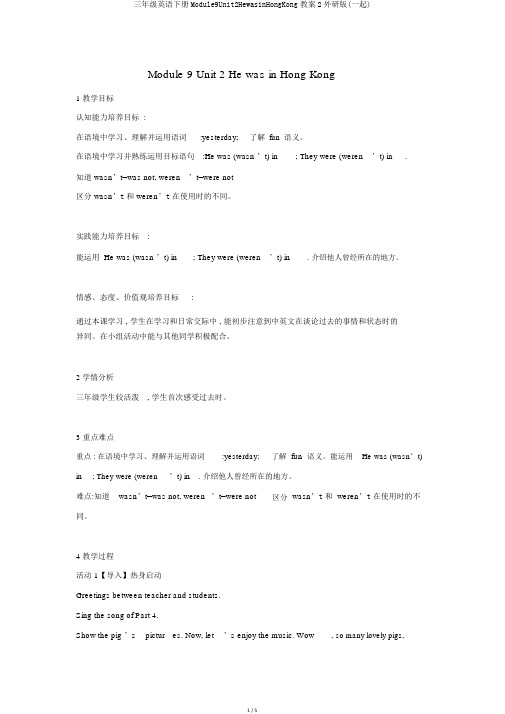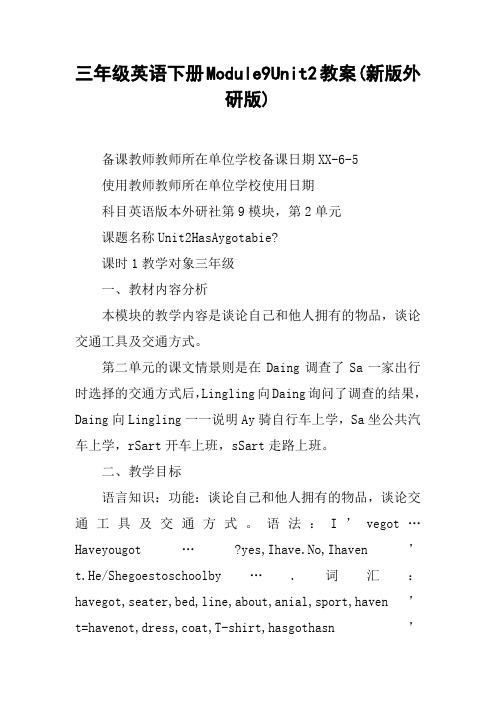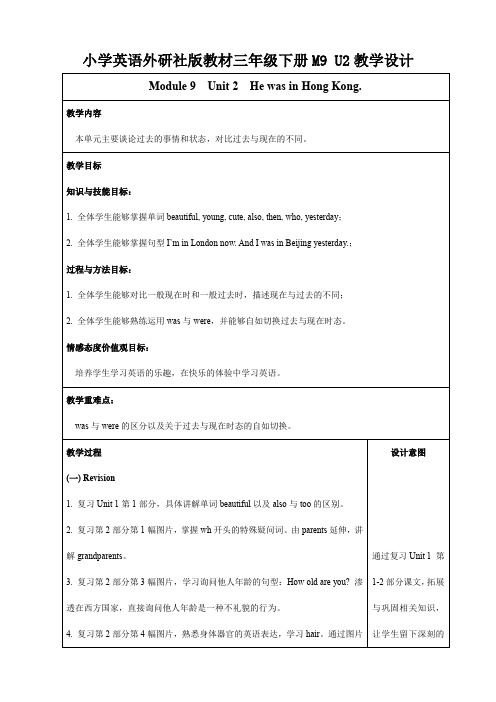三年级英语下册Module9Unit2HewasinHongKong教案2外研版(一起)
- 格式:docx
- 大小:24.44 KB
- 文档页数:5

Module 9 Unit 2 He was in Hong Kong1教学目标认知能力培养目标 :在语境中学习、理解并运用语词:yesterday;了解fun语义。
在语境中学习并熟练运用目标语句:He was (wasn ’t) in; They were (weren’t) in .知道 wasn’t=was not, weren’t=were not区分 wasn’t和 weren’t在使用时的不同。
实践能力培养目标:能运用 He was (wasn ’t) in; They were (weren’t) in. 介绍他人曾经所在的地方。
情感、态度、价值观培养目标:通过本课学习 , 学生在学习和日常交际中 , 能初步注意到中英文在谈论过去的事情和状态时的异同。
在小组活动中能与其他同学积极配合。
2学情分析三年级学生较活泼, 学生首次感受过去时。
3 重点难点重点 : 在语境中学习、理解并运用语词:yesterday; 了解fun 语义。
能运用He was (wasn’t) in; They were (weren ’t) in . 介绍他人曾经所在的地方。
难点:知道wasn’t=was not, weren’t=were not 区分wasn’t和weren’t在使用时的不同。
4教学过程活动 1【导入】热身启动Greetings between teacher and students.Sing the song of Part 4.Show the pig ’s pictur es. Now, let’s enjoy the music. Wow, so many lovely pigs,do you like i t? This time, let ’s sing together with gesture, OK? (CD-ROM)Look, can you say?Revision.Show the photos of Amy and Amy’s grandparents. (now and then)T:Look at these photos. Do you remember who are they? Can you talk about them?S:They were very young then. But they are very old now.T:How about Lingling? Say with your partner.S: Her hair was very short then. But now it ’s longb. Show the funny pictures. (now and then)T: Let ’s look at some funny pictures! This time, can you say now and then?S: It was an egg then, but it’s a chicken now.T: Look, more funny pictures, can you say, too? Discuss in groups.S: It was a kedou then, but it ’s a frog now. It was a warm then, but it ’s a butterfly now. It was a warm then, bu t it ’s a grass now活动 2【讲授】课文呈现1. Lead-inT: Look! Our friend ET iscoming. Say hello to him. Can you say the difference between now and then?S: He was short then,but he is tall now. He was small then, but he’s big nowT: Yes. Now he is big. He can travel by himself. Do you want to know where was heyesterday? Let’s have a look. (CD-ROM)T: Where was he yesterday? Where is ET now?S: “I was in Beijing yesterday. I am in London now. ”教师讲授新词“yesterday ”。

三年级下册英语教学设计-Module 9 Unit 2 He was in HongKong|外研社(一起)教学目标1.能够听懂、会说、会读、会写本单元单词和句型。
2.能够用简单的英语介绍自己的旅行经历。
3.能够通过小组合作讨论文章并分享旅行感受。
教学重点和难点教学重点1.单词和短语:tall, building, museum, statue, theatre, harbour, sure, buy, postcard, yesterday, tomorrow, last week, next week。
2.句型:Where did you go on your holiday? I went to Hong Kong. What did you do there? I visited some places of interest. Did you buy any souvenirs? Yes, I bought a postcard for my friend. How was your trip? It was great!教学难点1.过去式的使用。
2.单词和短语的正确发音和拼写。
教学准备1.教材《外研社三年级英语》下册。
2.包含单词和短语的图片或卡片。
3.连续剧片段。
4.提供手工制作明信片的材料。
教学过程Step 1:导入新课1.教师播放连续剧片段,调动学生学习兴趣,引出本单元话题——旅行。
2.老师制作PPT,与学生分享自己的旅行经历,介绍旅游景点,并利用幻灯片呈现旅游照片。
3.学生就教师的旅行经历提问。
Step 2:分享旅游经历1.让孩子们搭档,分享自己和同桌的旅游经历,回答以下问题:–Where did you go on your holiday?–What did you do there?–Did you buy any souvenirs?–How was your trip?2.老师从几组同学中随机抽取几组进行听写和点评。

三年级英语下册Module9Unit2教案(新版外研版)备课教师教师所在单位学校备课日期XX-6-5使用教师教师所在单位学校使用日期科目英语版本外研社第9模块,第2单元课题名称Unit2HasAygotabie?课时1教学对象三年级一、教材内容分析本模块的教学内容是谈论自己和他人拥有的物品,谈论交通工具及交通方式。
第二单元的课文情景则是在Daing调查了Sa一家出行时选择的交通方式后,Lingling向Daing询问了调查的结果,Daing向Lingling一一说明Ay骑自行车上学,Sa坐公共汽车上学,rSart开车上班,sSart走路上班。
二、教学目标语言知识:功能:谈论自己和他人拥有的物品,谈论交通工具及交通方式。
语法:I’vegot…Haveyougot…?yes,Ihave.No,Ihaven’t.He/Shegoestoschoolby….词汇:havegot,seater,bed,line,about,anial,sport,haven’t=havenot,dress,coat,T-shirt,hasgothasn’t=hasnot,by,bus,car.听说:I’vegot…Haveyougot…?yes,Ihave.No,Ihaven’t.He/Shegoestoschoolby….读写:havegot,haven’t=havenotby,bus,car.情感态度:在小组活动中与其他同学积极配合和合作。
文化意识:在学校和日常交际中,能初步注意到中外文化的异同。
任务:调查同学上学时采取的交通方式。
三、学习者特征分析本单元的学习内容围绕着自己拥有的新东西进行,孩子们愿意展示自己的新东西,并且愿意认识自己身边的东西,更乐于交流。
四、教学策略选择与设计积极运用所学英语参与游戏活动。
五、教学环境及资源准备Tapecardsrealobjects…六、教学过程教学过程教师活动学生活动设计意图及资源准备一、classopeningandrevie二、Neconcepts三、classclosing.安全教育:Don’tplayneartheriveralone.arerHavethestudentssaythedifferenttypesoftransportthatt heyseeinchina.ritetheirsuggestionsontheboard.Exaple:BusbiecaraltrainotorcycleinibustaxitraferrylorryvanNotethatIillneedtohelpthestudentsiththenevocabulary onthelist.Tellthestudentstocopythelist.thenexplainthattheyill heatsoeeansoftransportentionedinActivity2,theyshoul dlistencarefullyandticanyitestheyhearthatareontheli stListenandchant.Extendthechantbyreplacingtheordsoftransportithother ordsintroducedinthearer.Exaple:T:here’sthecap?He’sgotacar.It’sanicecar.rite‘he’sgot/She’got…’ontheboard,andasthestudentsiftheirother/fatherhasgo tabieoracar.Listenandsay.Afterlisteningtothetape,dofurtherpracticeoftheprese nttenseiththeclass.Drathisgridontheboard:biebuscaralASasSartrSartAstheclassquestionstohelpepletethegridithticsinther ightbox.Exaple:T:HodoesAygotoschool?Ss:Shegoestoschoolbybie.T:HodoesrSartgotoor?Ss:Hegoestoorbycar.ritethequestionsontheboardandhavethestudentsasandan serinpairs.Looandsay.Forhoeor,getthestudentstofindouthotheirparentsgotoo r.Inclass,getsoeofthestudentstostandupandreadouttheir sentences.listenandsay,thenchant.Beforesayingthechant.hilesayingthechant.Aftersayingthechant.playthegae,folloandsay.Playthisgae.Asandanser,thenticHoeor.Greetingtoteacherforthearingup.Havethestudentssaythedifferenttypesoftransportthatt heyseeinchina.ritetheirsuggestionsontheboard.Exaple:Busbiecaraltrainotorcycleinibustaxitraferrylorryvan Saythesentencesonebyone.listeningtothetape,finishthechartanddotheexercises.aeupadialogueinpairs.Anserthequestionsontheboard.Astheirparentshotogotoor?Listentothetape,thenlearnthenechant.Playagaeforthepractice.Notethehoeor.热身活动帮助学生进入英语学习状态。

小学英语外研社版教材三年级下册M9 U2教学设计对比,说出The girl’s hair was long then. But now the girl’s hair is short.5. 复习第2部分最后一幅图片,学习cute。
并总结形容人物性格特点的形容词都有哪些。
(二) Warming up1. 播放54页第4部分歌曲。
2. 结合自己的实际情况,改编新曲,重新创作并演唱。
I was ____, but now I’m ____.I was ____. Now I’m ____. I can ____!I was a baby, but now I’m a child.I was ____. Now I’m not. I’m a(n) ____ boy / girl.(三) Presentation1. 学习教材53页第1部分。
找出一般现在时和一般过去时的句子。
学习yesterday。
2. 梳理有关时态的时间等标志词。
(四) Consolidation and practice1. 教材54页第3部分。
Find and say。
利用句型:… was / were in … .描述图片。
2. Look and say. 例:The children were in Classroom A yesterday. But now they are in Classroom B.(五) Summary★一般过去时;★重点单词:was, were, young, beautiful, also, then, who, old, yesterday;★重点句子:I’m in London now. And I was in Beijing yesterday.(六) Homework1. 唱熟课本54页第4部分歌曲。
2. 完成卷子作业。

Module9 Unit2 He was in Hong Kong (说课稿)一、教材分析本课是外研版英语三年级下册Module9 Unit2的课文,主要通过介绍一个男孩去香港旅游的经历,来帮助学生了解香港的文化、名胜古迹和特色食品等。
主要涉及的语言点包括过去式的动词和时间状语。
二、教学目标1.能够听懂、理解和模仿课文,并掌握其中的单词和短语;2.能够使用过去式的动词来描述过去的事件;3.能够根据图片和提示句子,自己编写句子来描述过去的经历;4.能够听懂简单的英语问答,回答自己的旅游经历。
三、教学内容及方法1. New words and phrases本课的新单词包括 go, visit, take, tram, ferry, cable car, Victoria Peak, the Star Ferry, the Peak Tram, dim sum, egg tart, Kowloon Park 和Avenue of Stars。
通过游戏表演、图片展示、单词卡片等多种方式进行教学。
2. Talk about picture通过展示一些图片,引导学生问答和对话,让学生能够根据图片及简单的提示句子来描述自己的旅游经历。
3. Listen and read通过听录音、阅读课文、模仿朗读等活动,来帮助学生掌握课文内容和语音语调。
4. Highlight the past tense verbs and time phrases通过强调课文中出现的过去式动词和时间状语,来帮助学生掌握过去式的用法和时态。
5. Role play以小组为单位,进行配对练习,模拟旅游过程中的问答场景,培养学生的口语表达能力。
四、教学过程1.首先展示一些图片,让学生问答和对话,引入本课的话题和语言材料。
2.教师通过图片和单词卡片来介绍本课的新单词和短语,并进行单词拼写和朗读练习。
3.听录音,跟读课文,强调过去式动词和时间状语的用法和时态。

三年级英语下学期M9U2He was in Hong Kong 教案一、教学目标1.了解香港这座城市的基本情况和文化特色。
2.学习并掌握一些有关城市旅游和交通的英语词汇,如bus、tram、train、peak等。
3.通过听、说、读、写等多种方式,掌握本课对话的语音语调、词汇句型及其运用。
4.提高学生们的英语口语和听力能力,让他们能够自信地运用英语进行交流和表达。
二、教学重点和难点1.了解并掌握有关香港的基本情况和文化特色。
2.学习交通工具的英语词汇。
3.听懂、运用本课对话中的句式和词汇,提高英语口语表达能力。
三、教学过程1. 导入(1)通过展示香港的相关图片和视频,简要介绍香港的地理位置、人口、经济、文化等基本情况;同时介绍香港的著名景点和交通方式。
(2)通过课件展示交通工具的图片,让学生认识并学习一些常用的英语词汇,如bus、tram、train、peak等。
2. 学习重点1)介绍香港包括地理位置、人口、经济、文化等基本情况。
可通过图片、视频等多种途径进行介绍。
同时也可以介绍一些著名的香港景点,如维多利亚港、太平山、珍珠岛等,让学生了解香港的文化特色。
#### 2)交通工具的英语词汇讲解一些常用的交通工具的英语名称,如bus 公交车、tram 电车、train 火车等。
3. 教学难点1)语音语调的准确掌握针对学生容易发音不准的单词,进行例句演练,让学生模仿老师的语音语调进行朗读,加深印象。
#### 2)英语词汇的记忆通过游戏、填空等方式巩固交通工具的英语词汇,让学生更好地掌握。
4. 拓展延伸(1)让学生自己制作一份有关香港的信息卡片,分享给同学们。
(2)通过网上搜索、采访等方式,让学生更深入地了解香港,提高其英语听说能力。
四、教学反思本教案以香港为背景,通过介绍香港的基本情况和文化特色,帮助学生更好地了解这座城市,同时又涉及到了交通工具等方面的英语词汇学习,针对学生的实际情况进行个性化教学,提高学生的英语口语和听力能力。
三年级下册英语教案-Module 9 Unit 2《He was in Hong Kong》| 外研社(一起)教学目标1. 知识与技能:学生能够理解并运用过去时态描述过去的活动。
学生能够听懂、会说、会读本课的关键词汇和句型,如:“He was in Hong Kong”,“She was in Beijing”等。
学生能够通过图片和情景创设,运用过去时进行简单的英语交流。
2. 过程与方法:通过角色扮演、小组讨论等形式,提高学生的英语听说能力和合作能力。
利用多媒体教具,增强学生的学习兴趣和参与度。
3. 情感态度与价值观:培养学生对英语学习的兴趣,激发学生的求知欲。
通过学习内容,增进学生对不同文化的认识和尊重。
教学内容1. 词汇: Hong Kong, Beijing, London, New York, last week, last year等。
2. 句型:“Where was he/she last week/year?”“He/She was in Hong Kong/Beijing”教学重点与难点1. 重点:学会使用过去时态描述过去的活动。
正确运用本课的关键词汇和句型进行交流。
2. 难点:正确使用过去时态,区分过去时与现在时的用法。
正确发音并记忆新词汇。
教具与学具准备1. 教具:多媒体课件图片或实物展示2. 学具:学生用书练习册彩色笔教学过程1. 热身:通过简单的日常对话,复习过去时的相关知识。
展示与本课相关的图片,引导学生预测本课内容。
2. 新课导入:利用多媒体课件,展示课文情景,引导学生听懂并跟读关键句型。
通过图片或实物展示,教授新词汇,并进行适当的练习。
3. 互动活动:分组进行角色扮演,模拟课文情景,练习新学句型。
小组讨论,让学生用自己的话描述过去的活动。
4. 巩固练习:完成练习册上的相关练习,巩固所学知识。
教师通过提问,检查学生对知识的掌握情况。
学生进行自评和互评,分享学习心得。
板书设计关键词汇和句型突出显示,辅以简洁明了的图表和示例。
外研版一起小学英语三下册《Module 9Unit 2 He was in Hong kong 》word 教案Unit 2 He was in Hong Kong.Teaching Aims: 1. Review: was, wasn’t, were, weren’t.2. Learn new sentence patterns. Notes:Teaching important points: 1. Learn to say: In the holidays, Samwas in …, Mum and Amy were in … 2. Master: page 28: activity 1 Teaching difficultpoints: 1. Can read the text in this class. Students Analysis: This content is not difficult. It’seasy to understand and Ss can express.There are several new words in thistext. Maybe they can’t read itfluently now.Teaching Aids:Tape, tape recorder, wall chartTeaching Procedures:Step 1: Warming up1. Sing to greeting.2. Sing a song: <I was fat>.Step 2: Revision1. Review: was, were2. Look pictures and say.3.Review: wasn’t, weren’t4. Look pictures and say.5. Page 26: Activity 11) Point to the sentences.2) Read the text after tape.6. Page 27: Activity 21) Read the dialogue together.2) Read the dialogue in roles.Step 3: Presentation1. Page 28: activity 11) Listen to the tape.2) Answer: Where were Mum and Amy? Where was Sam?Where was Dad?3) Learn to say: Sam was in Beijing.Dad was in Hong Kong.Mum and Amy were in London.4) Bb: Sam was in Beijing.Dad was in Hong Kong.Mum and Amy were in London5) Understand: I was with Daming at Daming’s flat. It was fun!6) Read the text after tape.7) Read by yourselves.8) Try to read the text together.2. Page 28: activity 21) Look at the pictures.2) Express: … was in …… and … were in…3. Read the word list.。
Module 9 Unit 2 He was in Hong Kong教案1教学目标语言知识全体学生能运用: He was in Hong Kong. ,并理解运用:yesterday, weren’t = were not, wasn’t = was not, fun。
语言技能谈论过去的事情和状态,对比过去与现在的不同。
能够表达过去和现在所处的位置。
学习策略在学习新的语言结构时,遇到问题主动向老师或同学请教文化意识在学习和日常交际中,能初步注意到中英文在谈论过去的事情和情况时的异同情态态度在小组活动中能与其他同学积极配合和合作2学情分析由于本模块是学生第一次接触一般过去时,他们在这一时态的理解上可能有一定困难。
所以在“was, were”与“am, is, are”的区分运用上,学生可能会有各种疑惑和错误,老师要通过直观的图片对比,让学生理解一般过去时的显著特征,并且通过多种活动来运用这一新知识点,来巩固和运用。
3重点难点教学重点运用:He was in Hong Kong.教学难点谈论过去所处的位置,对比过去与现在的不同4教学过程活动1【导入】导入Preparation老师出示三幅图片:T: It was very cold yesterday.It was snow.My bay was very heavy.And I was very happy.Why?Because I was in Harbin yesterday.Now I am in Dalian.学生很纳闷,而后老师说出原因。
活动2【导入】PresentationT: Where were you in holidays?3 T: Let’s listen, and find out:Where was he yesterday?T: teach: yesterdayT: 现在我们知道了Miss Fei 和小外星人的假期都去了哪里。
三年级下册英语教案《Module 9 Unit 2 He was in Hong Kong》外研社(一起)教学目标1. 知识与技能:学生能够理解并正确使用过去时态描述过去的经历和活动。
2. 过程与方法:通过听力练习、角色扮演和小组讨论,学生能够提高英语听说能力和合作能力。
3. 情感态度价值观:培养学生对多元文化的兴趣和尊重,增强国际视野。
教学内容1. 词汇:复习与香港相关的词汇,如“skyline”、“harbour”、“Disneyland”等。
2. 句型:使用过去时态描述过去在某个地方的经历,如“He/She was in Hong Kong.”。
3. 文化背景:简单介绍香港的地理、文化特点和旅游景点。
教学重点与难点1. 重点:正确运用过去时态描述过去的经历。
2. 难点:理解并运用过去时态的构成,如动词过去式变化。
教具与学具准备1. 教具:多媒体教学设备、PPT课件、香港旅游图片。
2. 学具:学生手册、彩色笔、图画纸。
教学过程1. 导入:通过展示香港的图片和视频,引起学生的兴趣,复习相关词汇。
2. 听力练习:播放录音,让学生听并理解对话内容。
3. 角色扮演:学生分组,模拟对话情景,练习使用过去时态。
4. 小组讨论:学生分享自己去过的地方和经历,用英语进行交流。
板书设计1. Module 9 Unit 2 He was in Hong Kong2. 关键词汇:skyline、harbour、Disneyland3. 主要句型:He/She was in Hong Kong.作业设计1. 书面作业:完成练习册中有关过去时态的练习题。
2. 口头作业:回家后向家长用英语介绍自己的一次旅行经历。
课后反思通过本节课的学习,学生应能够运用过去时态描述过去的经历。
教学中应注意纠正学生的发音和语法错误,同时鼓励学生积极参与课堂活动,提高英语口语表达能力。
在后续的教学中,可以增加更多关于不同国家和文化的教学内容,以拓宽学生的国际视野。
Module 9 Unit 2 He was in Hong Kong1教学目标认知能力培养目标:在语境中学习、理解并运用语词:yesterday;了解fun语义。
在语境中学习并熟练运用目标语句:He was (wasn’t) in…; They were (weren’t) in….知道wasn’t=was not, weren’t=were not区分wasn’t和weren’t在使用时的不同。
实践能力培养目标:能运用He was (wasn’t) in…; They were (weren’t) in….介绍他人曾经所在的地方。
情感、态度、价值观培养目标:通过本课学习,学生在学习和日常交际中,能初步注意到中英文在谈论过去的事情和状态时的异同。
在小组活动中能与其他同学积极配合。
2学情分析三年级学生较活泼,学生首次感受过去时。
3重点难点重点:在语境中学习、理解并运用语词:yesterday;了解fun语义。
能运用He was (wasn’t) in…; They were (weren’t) in….介绍他人曾经所在的地方。
难点:知道wasn’t=was not, weren’t=were not区分wasn’t和weren’t在使用时的不同。
4教学过程活动1【导入】热身启动Greetings between teacher and students.Sing the song of Part 4.Show the pig’s pictur es. Now, let’s enjoy the music. Wow, so many lovely pigs,do you like it? This time, let’s sing together with gesture, OK? (CD-ROM)Look, can you say?Revision.Show the photos of Amy and Amy’s grandparents. (now and then)T: Look at these photos. Do you remember who are they? Can you talk about them? S: They were very young then. But they are very old now.T: How about Lingling? Say with your partner.S: Her hair was very short then. But now it’s long…b. Show the funny pictures. (now and then)T: Let’s look at some funny pictures! This time, can you say now and then?S: It was an egg then, but it’s a chicken now.T: Look, more funny pictures, can you say, too? Discuss in groups.S: It was a kedou then, but it’s a frog now. It was a warm then, but it’s a butterfly now. It was a warm then, bu t it’s a grass now…活动2【讲授】课文呈现1. Lead-inT: Look! Our friend ET is coming. Say hello to him. Can you say the difference between now and then?S: He was short then, but he is tall now. He was small then, but he’s big now…T: Yes. Now he is big. He can travel by himself. Do you want to know where was he yesterday? Let’s have a look. (CD-ROM)T: Where was he yesterday? Where is ET now?S: “I was in Beijing yesterday. I am in London now.”教师讲授新词“yesterday”。
a. 创设真实情境T: What day is today? What about yesterday?S: Today is Wednesday. It was Tuesday yesterday.T: Look, today is sunny. What was the weather like yesterday?S: Yesterday was sunny, too.b. 语音教学将yesterday按音节分为yes—ter—day, 分别让学生感知发音规律。
在ter的读音上,让学生读几组词(farmer, river, tower, water)通过自己体会,总结出ter的读音。
通过手势练习,和利用板书磁扣,让学生进一步感知yesterday的音节。
2. Task: So,ET likes traveling very much. Today, if you try your best, he will take you to so many places. Are you ready? Today we’re going to learn Module 9 Unit 2. (板书题目) 通过今天的学习,我们将学会描述自己曾经去过的地方,以及那个时候的自己与现在有什么不同。
3. New Teaching1) 自主探究T: Look, who is he? (PPT出示Sam头像)S: He is Sam.T: Yes. Can you guess? Sam wrote a ------?(PPT出示信的信尾)S: Sam wrote a letter.T: Yes. Sam wrote a letter to ------? (PPT出示信的信头)S: Sam wrote a letter to Lucy.T: Ok, boys and gir ls, what’s in this letter, what did he write to Lucy? Let’s look at these three pictures carefully. What can you see? Who ca you see? Where can you see? (PPT展示课文三幅图片)S1: I can see Amy, Ms. Smart and Amy’s grandparents.S2: I can see Sam and Daming.S3: I can see Mr. Smart….T: Yes, you are right! (教师粘头饰)Any other information in these pictures?(教师板书表格)2) Listen and connect (Part 3)T: Ok, boys and girl s, maybe you get many different answers. Now, let’s have a look what did Sam write to Lucy. Watch the CD-Rom and try to match.T: OK, children, Where were they?S1: Ms Smart and Amy were in London.S2: Sam was in Beijing.S3: Mr. Smart was in Hong Kong.教师板书,学生机械操练句型。
3) Listen again and try to underline the detailsT: Where were / we ren’t Amy, mum and dad in the holidays? Where was Sam yesterday? Open your books, let’s listen again, try to underline the sentences.S: They weren’t in Beijing….教师板书,学生机械操练句型,讲解wasn’t=was not, weren’t=were not。
a. Quickly sayb. Let’s imitate.c. Box GameT: Let’s play an interesting game! Look, there are two boxes. One is a happy face, one is a sad face.教师示范,从盒中抽取带有城市的卡片,运用语句“I wasn’t in …yesterday. / I was in…yesterday.”选取学生到前面抽取卡片说句子。
T: Ok. This time, c an you tell me where he was and where he wasn’t yesterday? S: He/she was in…yesterday. He/she wasn’t in … yesterday.T: Do you want to come to the front in pairs?S: Yes! We were in … yesterday. We weren’t in … yesterday. They were in … yesterday. They weren’t in … yesterday.4) a. Listen and repeatb. Read by yourselfc. Find the missing words. 课文填空(was/wasn’t/were/weren’t)活动3【活动】巩固操练T: Look, who is he?S;Ke nan!T:今天我们要跟着柯南一起做游戏。
There are two games.First game----一起来找茬!This is a “find and say” game. Are these two pictures same? What’s the difference? Try to talk with your partners!T: Yesterday, our school was stolen (被盗). Who is the thief(小偷)? Let’s have alook! PPT 出示练习,在真实情境中操练“He wasn’t in _____.”以及“They weren’t in _____.”句型。